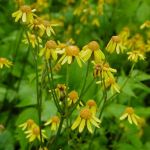| Common Name: |
Golden Ragwort |
| Other Names: |
Liferoot, Squaw Weed |
| Botanical Name: |
Senecio aureus syn. Packera aurea |
| Genus: |
Senecio |
| Family: |
Asteraceae |
| Native Location: |
Eastern N America to Texas |
| Cultivation: |
Damn to wet soil in sun or partial shade. |
| Propagation: |
By seed sown in autumn or spring; by division in autumn or spring. |
| Harvest: |
Plants are cut before flowering and dried for use in infusions and liquid extracts. Roots are lifted in autumn and dried for powder. |
| Height: |
15-75cm (6-30in) |
| Width: |
15-60cm (6-24in) |
| Hardiness: |
Z5-9 |
| Parts Used: |
Whole plant, rhizomes |
| Properties: |
A bitter, astringent herb that is diuretic stimulates the uterus, controls bleeding. |
| Medicinal Uses: |
Internally for failure to menstruate, menopausal symptoms, prolonged labor, and pulmonary hemorrhage. Externally for vaginal discharge. |
| Warning: |
Contraindicated during pregnancy.
No longer considered safe for internal use.
This herb is subject to legal restrictions in some countries. |
| Bibliography: |
Encylopedia of Herbs by Deni Brown Copyright ©: 1995, 2001 Dorling Kindersley Limited pg 366
|

